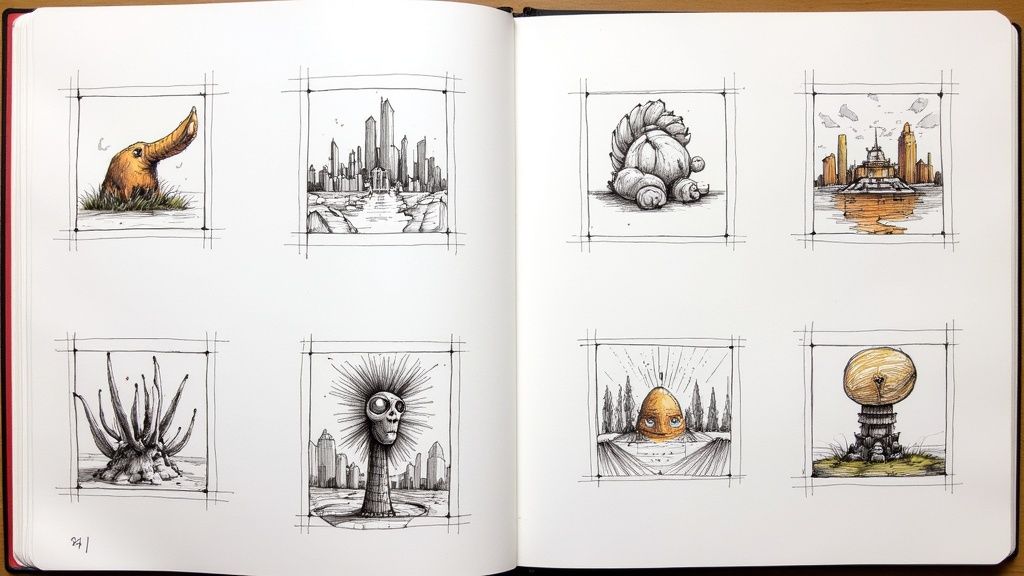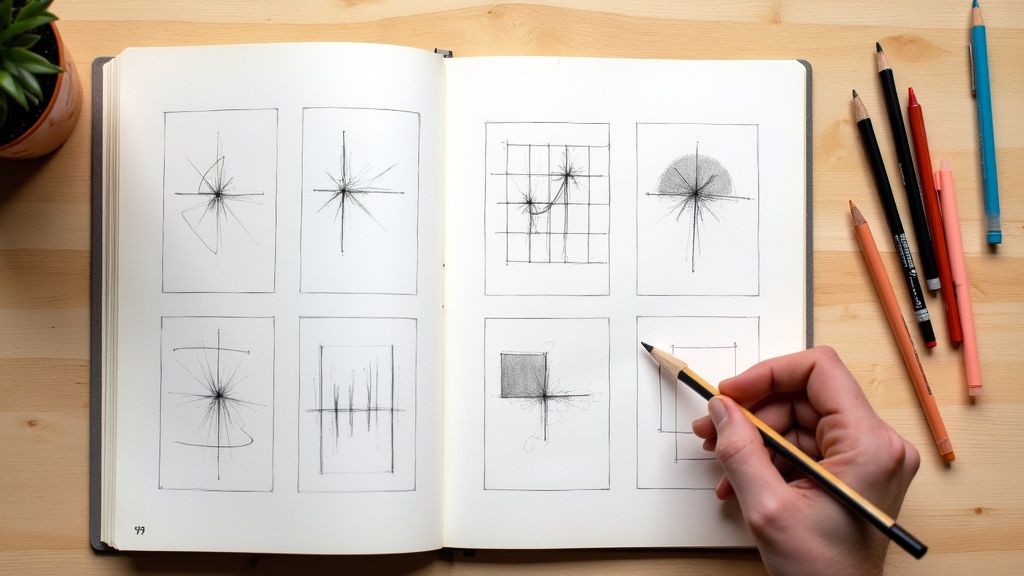As the leaves turn and a chill fills the air, artists everywhere feel the pull of the spooky season. Finding the right inspiration, however, can be as tricky as navigating a haunted corn maze. This guide moves beyond the generic to offer unique and actionable halloween drawing ideas designed to challenge your skills and fill your sketchbook. We are ditching the vague prompts and instead providing a structured approach to creating memorable art.
This listicle is built to give you a creative advantage. We will explore fresh takes on classic themes, from the anatomical intricacies of skeletal figures to the vintage charm of early 20th-century postcards. You will learn specific techniques for crafting spooky jack-o'-lantern faces, designing atmospheric haunted house silhouettes, and capturing the dynamic movement of gothic bats in flight.
Each concept is broken down into practical tips and clear examples to help you conquer artist's block and create your most memorable Halloween art yet. Forget searching aimlessly for ideas; this curated collection offers concrete starting points for any skill level. Get your pens, pencils, and styluses ready, it's time to bring some creative magic to the macabre.
1. Spooky Jack-o'-lantern Faces
The Jack-o'-lantern is an undeniable icon of Halloween, making its expressive face one of the most classic and versatile Halloween drawing ideas. This concept involves more than just drawing a pumpkin; it's about capturing a personality through carved features. From a friendly, gap-toothed grin reminiscent of classic Disney decorations to a menacing scowl seen in traditional folk art, the possibilities are endless. This idea is perfect for artists of all skill levels, as it allows for both simple, graphic designs and complex, detailed illustrations.
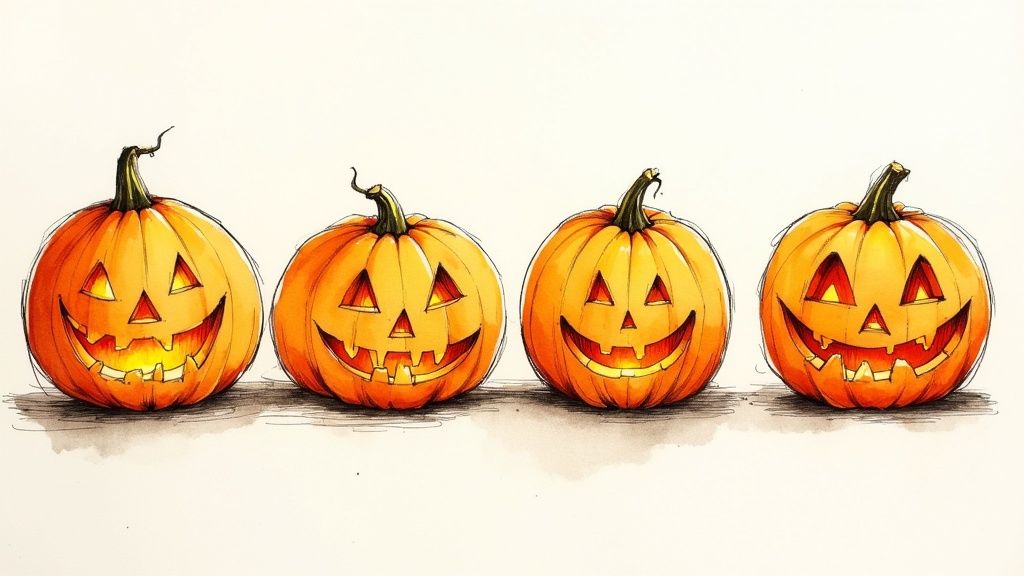
This approach is especially effective for setting a specific mood. A collection of cheerfully glowing pumpkins can create a welcoming, family-friendly scene, while a single, sinister face can evoke a sense of foreboding and horror. It’s an exercise in character design using a very limited, yet powerful, canvas.
How to Execute This Idea
To bring your Jack-o'-lantern to life, focus on the core elements that give it character: the eyes, nose, and mouth.
- Start with Basic Shapes: Begin by sketching the overall pumpkin form, then use simple geometric shapes like triangles, squares, and circles for the facial features. This helps establish the core expression before you add detail.
- Play with Asymmetry: A perfectly symmetrical face can look static. Introduce character by making one eye slightly larger or tilting the mouth at an angle. This small change can transform a generic pumpkin into a unique personality.
- Create a Candle Glow: The internal glow is key. Use warm oranges and yellows for the light source. Apply soft, diffused highlights on the inside walls of the carved sections and a brighter, more intense color at the "source" of the light, typically the bottom center. Add a subtle glow spilling out onto the pumpkin's outer surface for a realistic effect.
- Experiment with Expressions: Don't limit yourself to a standard grin. Try drawing a surprised "O" mouth, a winking eye, or even a face that looks nauseous or sleepy. The goal is to tell a story with a single expression.
2. Haunted House Silhouettes
A haunted house silhouette is a powerful and atmospheric Halloween drawing idea that relies on shape and mood rather than intricate detail. This concept focuses on capturing the eerie essence of Gothic architecture, such as spooky Victorian mansions or decrepit castles, set against a dramatic sky. Drawing inspiration from masters of mood like Tim Burton and Edward Gorey, this idea is perfect for creating compositions that evoke mystery, dread, and a sense of timeless horror.
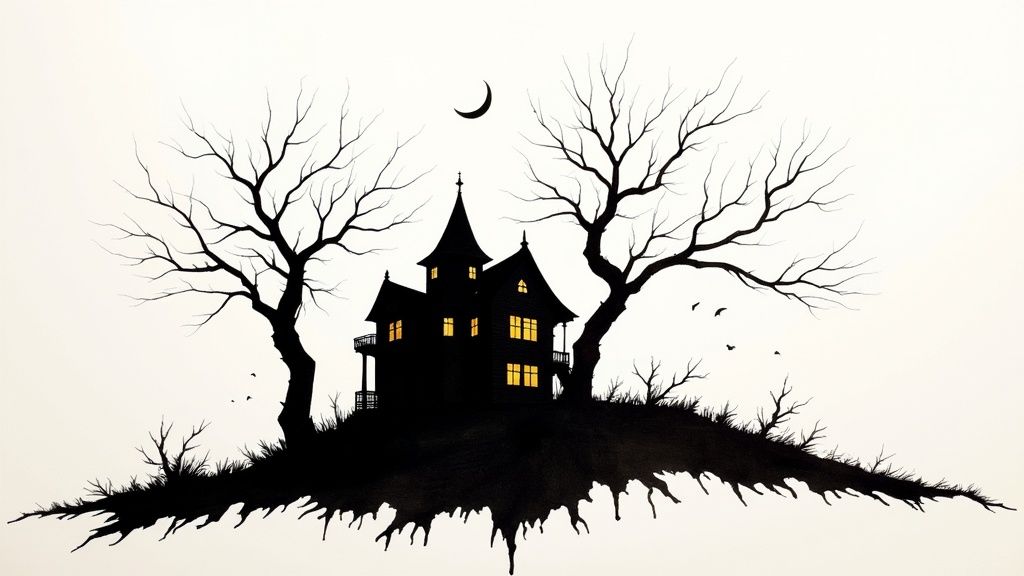
This approach is highly effective for telling a story through environment alone. A lone, jagged mansion on a hill can suggest isolation and despair, while a twisted, overgrown castle hints at ancient curses. It’s an exercise in using negative space and strong contours to build a narrative, making it one of the most compelling halloween drawing ideas for artists who love world-building. For more inspiration, you can find a variety of haunted house drawing ideas on Drawinglist.com.
How to Execute This Idea
To create a haunting silhouette, concentrate on the building's outline and the surrounding atmosphere to maximize the spooky effect.
- Use One-Point Perspective: Draw your haunted house using a one-point perspective to create a sense of dramatic depth and scale. Placing the vanishing point low on the horizon can make the structure look imposing and menacing.
- Emphasize Gothic Architecture: Incorporate key Gothic elements like pointed arches, sharp spires, and asymmetrical towers. Exaggerating these features, such as making a roof impossibly steep or a spire unnaturally sharp, adds to the unsettling feeling.
- Create Depth with Overlapping Elements: Place objects like gnarled trees, a crooked fence, or a flock of bats in front of the main structure. This layering technique adds depth to the scene and frames the haunted house effectively.
- Master Negative Space: Use negative space to define your windows and doorways. Instead of drawing the windows, draw the dark shape of the house around them, letting the bright color of the sky show through as an eerie, vacant glow.
3. Friendly Cartoon Ghosts
Not all Halloween spirits need to be terrifying. Creating friendly cartoon ghosts is a fantastic way to explore character design and emotion, making it one of the most heartwarming halloween drawing ideas. This concept shifts the focus from fear to fun, portraying ghosts as whimsical, cute, and approachable characters like Casper the Friendly Ghost or Boo from the Super Mario series. Their simple, flowing forms make them perfect subjects for artists of all levels, offering a canvas for expressive faces and playful scenes.
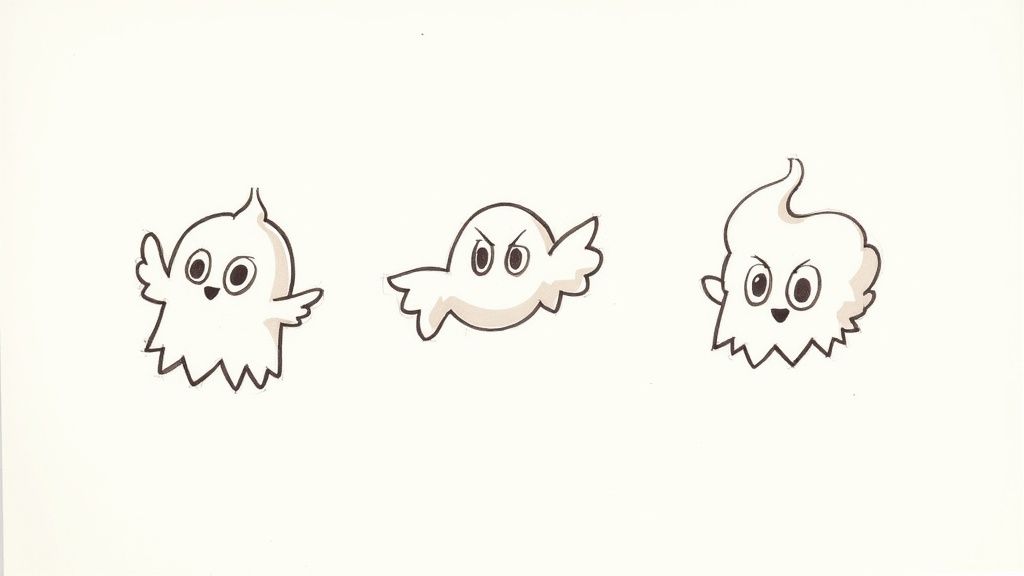
This approach is ideal for creating lighthearted and charming Halloween art that appeals to a broad audience. A single, shy ghost peeking from behind a pumpkin can tell a sweet story, while a group of giggling spirits can create a dynamic and joyful composition. It’s an exercise in conveying personality through simple shapes and expressions, proving that Halloween can be more sweet than spooky.
How to Execute This Idea
To give your spectral creations personality and charm, concentrate on their form, expression, and ethereal qualities.
- Embrace Curved Lines: Use smooth, S-shaped, and C-shaped curves to draw the ghost's body. This creates a sense of graceful, weightless movement, unlike the rigid lines you might use for a scarier creature.
- Focus on Expressive Eyes: Since ghosts often lack many features, their eyes do all the emotional heavy lifting. Experiment with large, glossy pupils for a cute look, happy U-shaped eyes for joy, or downturned brows for a sad or worried expression.
- Create a Transparency Effect: To make your ghost look see-through, draw the background elements first. Then, on a new layer or with a lighter touch, draw the ghost over them. Lower the ghost's opacity or gently erase parts of the background lines that show through its body to create a convincing spectral look.
- Design a Ghostly Family: Don't just draw one. Create a group of ghosts of different sizes and shapes. A tall, slender ghost next to a short, round one adds visual interest and implies relationships, turning a simple drawing into a family portrait.
4. Creepy Crawly Spiders and Webs
Nothing captures the essence of a haunted house or a forgotten crypt quite like the sight of spiders and their intricate webs. This Halloween drawing idea focuses on the arachnid itself, allowing artists to explore detailed anatomy and texture. Whether you aim for a hyper-realistic depiction straight from a nature guide or a stylized, monstrous creature from a horror film, this subject offers incredible depth. The interplay between the spider and its elaborate web creates a dynamic scene full of natural tension and gothic beauty.
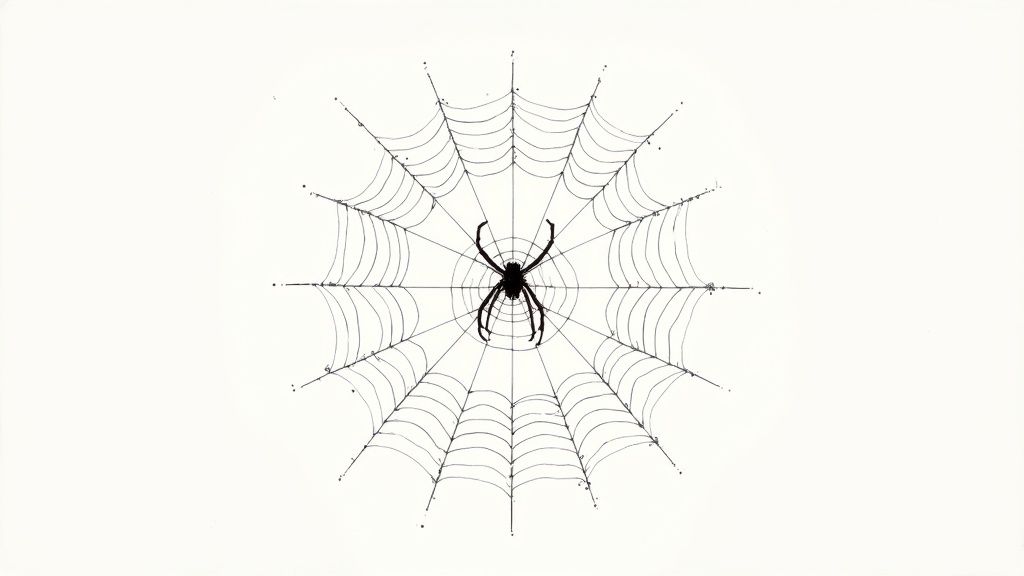
This approach is perfect for practicing fine line work and understanding composition. The web can serve as a complex background that frames the spider, or it can be the central focus itself, draped over another object to create an atmosphere of age and decay. It’s an excellent way to add a layer of chilling detail to any Halloween-themed illustration.
How to Execute This Idea
Drawing convincing spiders and webs is an exercise in patience and an eye for detail. Focus on structure and texture to make your creation stand out.
- Build the Web First: Begin with the basic radial structure of an orb-weaver's web. Draw a few lines originating from a central point, then connect them with a continuous, spiraling thread. For a more chaotic look, draw tangled, irregular threads to create a classic cobweb.
- Use Reference for Anatomy: To make your spider believable, look at reference photos. Pay close attention to the two main body segments (cephalothorax and abdomen), the eight legs, and the pedipalps near the mouth. This anatomical accuracy will elevate your drawing from a simple doodle to a compelling creature.
- Add Environmental Context: A web doesn't exist in a vacuum. Draw it stretching between tree branches, in the corner of a window pane, or covering a skull. Adding dew drops or captured insects to the web can also add a powerful narrative element.
- Vary Line Weight: Use thin, delicate lines for the silk threads of the web and bolder, textured lines for the spider's body. This contrast will create visual interest and help the spider pop from its background, making it the clear focal point of your eerie artwork.
5. Witch Silhouettes and Profiles
The witch is a quintessential Halloween figure, and focusing on her silhouette is a powerful way to create atmospheric and instantly recognizable art. This idea moves beyond a simple character portrait to emphasize the iconic shapes associated with witchcraft: the pointed hat, the crooked nose, the gnarled staff, and the flowing robes. Drawing a witch in profile or as a silhouette against a moonlit sky is a classic Halloween drawing idea that evokes a sense of ancient magic and folklore. This approach is excellent for artists looking to practice form, composition, and mood.
This method is particularly effective for telling a story with minimal detail. A silhouette can suggest a witch flying on her broomstick, stirring a cauldron, or casting a spell, leaving the finer details to the viewer's imagination. It’s an exercise in using negative space and strong, clear lines to create a dramatic and memorable image.
How to Execute This Idea
To create a compelling witch silhouette, concentrate on the defining shapes and atmospheric elements that make the character iconic.
- Focus on the Iconic Shape: The silhouette's power comes from its recognizability. Start by sketching the key features: a tall, pointed hat, a distinct facial profile with a sharp chin or nose, and the shape of a flowing cloak or tattered robes.
- Add Flowing Lines for Movement: Use long, curved lines to illustrate wind catching her hair, cape, or the bristles of her broomstick. This adds a dynamic quality, making the drawing feel alive rather than static.
- Include Environmental Magic: Enhance the silhouette by placing it within a magical context. Draw it against a large, glowing full moon, amidst swirling mist, or surrounded by bats. These background elements amplify the mystical mood.
- Study Historical References: Look at classic depictions of witches, from the fairy tale illustrations of Arthur Rackham to the dramatic villains in Disney films. This will provide inspiration for different poses, costumes, and overall character design.
6. Skeletal Characters and Anatomy
Moving beyond simple spooks, drawing skeletal characters offers a fascinating blend of anatomy and artistic expression. This idea challenges you to explore the very foundation of form, whether you're aiming for a photorealistic anatomical study or a stylized, animated character full of life. From the elegant calaveras of Día de los Muertos to the charmingly macabre figures in Tim Burton films, skeletons provide a unique canvas for storytelling and design. This concept is a fantastic way to practice proportions, line work, and character posing.
This idea is perfect for artists looking to strengthen their understanding of the human figure. By stripping characters down to their bones, you can focus purely on gesture, posture, and the mechanics of movement. It allows for a wide range of moods, from the somber and educational to the whimsically spooky, making it one of the most versatile halloween drawing ideas.
How to Execute This Idea
To create a compelling skeletal figure, focus on balancing anatomical structure with personality and movement.
- Study Basic Anatomy: You don't need a medical degree, but familiarizing yourself with the major bones like the skull, rib cage, pelvis, and limbs will make your drawings more convincing. Look at simplified anatomical charts to get started.
- Use Gesture Drawing: Begin with a quick, loose gesture drawing to establish the pose and flow of your character. This helps imbue the skeleton with energy and life, preventing it from looking stiff and static like a classroom model.
- Add Personality Through Poses: The pose tells the story. A skeleton slumped in a chair conveys a different feeling than one captured mid-dance. Use posture and limb placement to express emotions like joy, despair, or mischief. For more dynamic concepts, you can find inspiration for a skeleton dance on drawinglist.com.
- Consider Cultural Contexts: Explore different artistic interpretations. The decorative, celebratory style of Mexican sugar skulls is vastly different from the gothic horror skeletons seen in European art. Let these traditions influence your design choices, from patterns to accessories.
7. Vintage Halloween Postcards Style
Tapping into the charm of early 20th-century art offers a unique and nostalgic Halloween drawing idea. This concept involves recreating the distinct aesthetic of vintage Halloween postcards from the 1900s to the 1920s. These pieces are known for their whimsical yet slightly eerie blend of characters like grinning black cats, charming witches, and anthropomorphic pumpkins, all rendered with a specific, muted color palette and decorative flair. It's a fantastic way to create artwork that feels both classic and haunting.
This style is perfect for artists looking to tell a story and evoke a sense of history. The imagery often combines innocence with a subtle undercurrent of the supernatural, setting it apart from modern, more graphic horror themes. It’s an exercise in capturing a specific era's visual language, from its typography to its character designs.
How to Execute This Idea
To successfully replicate this retro aesthetic, focus on the signature elements that define vintage illustrations.
- Study Authentic Examples: Before starting, research real postcards from the early 1900s. Notice the common motifs, such as children in costumes, fortune-telling games, and personified vegetables. Pay attention to the slightly off-kilter proportions and expressive faces.
- Use a Limited, Muted Palette: Vintage printing techniques resulted in a specific color range. Stick to faded oranges, deep blacks, creamy off-whites, and sage greens. Avoid overly bright or neon colors to maintain authenticity.
- Incorporate Vintage Typography: The text was a key part of these postcards. Use decorative, serif, or art nouveau-style fonts for phrases like "A Joyous Hallowe'en" or "Halloween Greetings." Integrating the text into the composition is essential.
- Add Aging Effects: To complete the look, apply textures that mimic aged paper. Use digital brushes or traditional techniques to add subtle grain, faded spots, or slightly worn edges. This final touch sells the illusion of a genuine vintage artifact.
8. Gothic Bats in Flight
Bats are a quintessential symbol of the night, deeply woven into Gothic lore and Halloween traditions. This drawing idea focuses on capturing the dynamic elegance of bats in flight, moving beyond static silhouettes to explore their intricate anatomy and fluid movement. From a swarm erupting from a cavern to a lone creature gliding across a full moon, this concept offers a fantastic opportunity to practice perspective, motion, and atmospheric depth. This is a great Halloween drawing idea for artists who want to blend natural realism with spooky, stylistic flair.
This approach is highly effective for creating a sense of action and drama in your artwork. A detailed anatomical study can feel scientific and eerie, while a stylized flock against a stark background can evoke classic horror movie posters or comic book iconography. It’s an exercise in capturing energy and creating a compelling scene with a single, powerful subject.
How to Execute This Idea
To give your bats a sense of lifelike motion and Gothic atmosphere, concentrate on their unique wing structure and the environment they inhabit.
- Study Real Anatomy: Before you start, look at photos or scientific diagrams of bat skeletons and wings. Understanding the "finger" bones that support the wing membrane will help you draw more believable and varied poses, avoiding the stiff, triangular shapes often seen in cartoons.
- Use Video References for Flight: Bats have a complex, almost swimming-like flight pattern. Watch slow-motion videos of bats flying to understand how their wings fold and expand. This will help you draw them in dynamic mid-flight positions rather than just a flat, outstretched pose.
- Start with Silhouettes: To master the overall form, begin by practicing simple black silhouettes. This forces you to focus on creating a clear, recognizable shape. Experiment with different wing positions to build a library of poses before adding internal details.
- Create Atmosphere: Place your bats in a compelling environment. A stark, bright moon behind them creates a classic high-contrast look. Alternatively, you can draw them emerging from the dark entrance of a cave or swooping around the spires of a Gothic cathedral to add narrative and context.
9. Mystical Potion Bottles and Cauldrons
Channel your inner alchemist with a still life composition featuring mystical potion bottles and bubbling cauldrons. This Halloween drawing idea moves beyond characters and focuses on the magical tools of the trade. It’s an opportunity to explore textures like shimmering glass, bubbling liquids, and ancient metal, creating a scene steeped in mystery and supernatural energy. Inspired by everything from alchemical manuscripts to fantasy game concept art, this subject is perfect for artists who enjoy detail-oriented work and world-building.
This approach is excellent for practicing fundamental art skills, such as rendering transparency, light, and reflection, within a compelling and atmospheric theme. A shelf filled with curiously shaped bottles or a single cauldron emitting an eerie glow can tell a powerful story without a single figure. It's a fantastic exercise in creating mood through objects alone. For an in-depth guide on this specific theme, you can explore more ideas for creating a witch's potion lab on drawinglist.com.
How to Execute This Idea
To create a convincing magical still life, focus on the details that make each object unique and the atmosphere that ties them together.
- Render Glass and Liquids: Master the basics of drawing glass by focusing on highlights, reflections, and the distortion of what's behind it. Use reference photos of antique bottles to understand how light interacts with different shapes. For the potions, vary their viscosity; some might be watery and clear, others thick and murky.
- Design Unique Labels and Stoppers: Give each bottle a personality. Design custom labels with arcane symbols, cryptic text, or illustrations of ingredients. The stoppers can be just as creative, from simple corks to ornate, sculpted crystal or wax-sealed tops.
- Incorporate Magical Elements: Introduce supernatural details to elevate the scene. Add a soft, otherworldly glow emanating from a specific potion, wisps of magical smoke curling from a cauldron, or tiny sparkling particles floating in the air.
- Build an Atmospheric Composition: Arrange your objects to create a sense of depth and narrative. Place larger items like a cauldron in the background and smaller, more detailed bottles in the foreground. Use dramatic lighting, like a single light source, to cast long shadows and create a mysterious mood.
Halloween Drawing Ideas Comparison Matrix
Item | Implementation Complexity | Resource Requirements | Expected Outcomes | Ideal Use Cases | Key Advantages |
|---|---|---|---|---|---|
Spooky Jack-o'-lantern Faces | Low | Basic drawing tools | Classic Halloween expressions | Beginners, casual seasonal art | Easy, instantly recognizable |
Haunted House Silhouettes | Medium to High | Reference for perspective | Moody, atmospheric architectural art | Advanced artists, perspective practice | Builds architectural skills |
Friendly Cartoon Ghosts | Low to Medium | Simple shapes and expressions | Playful, approachable character art | Kid-friendly, character design | Versatile, encourages personality |
Creepy Crawly Spiders and Webs | Medium to High | Detailed references | Detailed naturalistic or stylized art | Detail work, pattern practice | Teaches symmetry and texture |
Witch Silhouettes and Profiles | Medium | Figure drawing knowledge | Iconic, storytelling figure drawings | Narrative art, figure practice | Rich storytelling, creative freedom |
Skeletal Characters and Anatomy | High | Anatomical references | Anatomically informed skeleton art | Anatomy study, both cartoon and realistic | Educational, versatile styles |
Vintage Halloween Postcards Style | Medium | Knowledge of vintage design | Nostalgic vintage aesthetic art | Historical styles, design-focused | Unique charm, combines art and design |
Gothic Bats in Flight | Medium to High | Wing anatomy references | Dynamic, atmospheric bat illustrations | Study of movement and anatomy | Good for anatomy and dynamic poses |
Mystical Potion Bottles and Cauldrons | High | Glass, liquid reference images | Detailed still life with magical effects | Still life, material rendering | Excellent for practicing complex effects |
Keeping Your Creative Cauldron Bubbling
With this comprehensive list of halloween drawing ideas, your sketchbook is now a gateway to the eerie, whimsical, and wonderfully macabre world of the spooky season. We've journeyed through a haunted landscape of artistic prompts, exploring everything from the classic grin of a jack-o'-lantern and the architectural dread of a haunted house to the intricate anatomy of skeletons and the nostalgic charm of vintage postcard art. Each concept offers a distinct opportunity not just to draw, but to tell a story.
The true magic, however, happens when you move beyond the individual prompts and begin to weave them together. The most compelling artwork often arises from unexpected combinations. Don't be afraid to experiment and push the boundaries of these foundational ideas. Imagine a skeletal character rendered in the soft, faded style of a vintage postcard. Picture a friendly ghost cautiously peering into a mystical potion bottle, or a gothic bat perched atop a perfectly carved pumpkin. These intersections are where your unique artistic voice can truly shine.
Turning Inspiration into Masterpieces
The value in exploring these diverse halloween drawing ideas extends far beyond simply filling a page. It's about building a versatile artistic toolkit that you can draw upon year-round.
- Mastering Light and Shadow: Practicing haunted house silhouettes and witch profiles will sharpen your understanding of negative space and dramatic lighting, skills crucial for creating depth and mood in any composition.
- Developing Character Design: Sketching friendly ghosts and expressive skeletons helps you hone your ability to convey emotion and personality through simple shapes and gestures, a cornerstone of compelling character art.
- Exploring Texture and Detail: Drawing creepy crawly spiders, intricate webs, and bubbling cauldrons provides excellent practice for rendering different surface textures, from the sticky silk of a web to the smooth, cool glass of a potion bottle.
By consistently practicing these themes, you are not just creating seasonal art; you are fundamentally improving your core drawing skills. You're learning to control line weight, compose a balanced image, and infuse your work with atmosphere and narrative.
Your Next Artistic Chapter
The most important takeaway is to remain curious and consistently seek out new challenges. This collection of nine ideas is a powerful starting point, designed to ignite your creative spark. Use them as a launchpad. Fill a sketchbook page with dozens of different jack-o'-lantern faces. Create a lineup of unique skeletal characters with different personalities. Design a set of magical potion bottles, each with its own distinct label and mysterious contents.
Let this Halloween be the season you commit to your craft. Embrace the spooky, celebrate the strange, and watch as your skills evolve with every stroke of the pen or pencil. The key is to keep your creative cauldron bubbling with fresh inspiration, ensuring you never face a blank page with uncertainty again.
Ready for an endless supply of creative fuel? If you're looking for more unique halloween drawing ideas or prompts for any other subject, the Drawing List generator is your ultimate creative partner. Visit Drawing List to discover thousands of curated ideas and keep your artistic journey moving forward, one masterpiece at a time.
